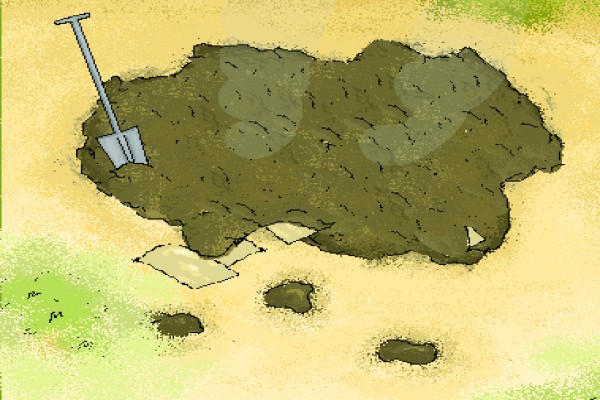Hāngi is iconic; the food that connects us to our ancestors, the best treat for all. Most importantly, forget your expensive, overhyped ham - Hāngi is the best Christmas dish, prove me wrong.
Hāngi, as we all know, takes a huge amount of work. You have to dig a hole, find the perfect rocks, get firewood, peel kumara for what feels like a million years, the list goes on. But digging a hole at home is one thing, getting away with it at your student flat is another.
Digging up your yard at a rental property usually requires permission from your landlord, some sort of consent. Tenants aren’t supposed to change the landscaping without permission, but surely a cheeky, temporary hāngi pit would be fine, right? You would think so, but in 2018, some teens in Auckland got fined for digging a hāngi pit, even after getting consent, because the new owners wanted the ‘grass resown’ after the pit was filled in. Interesting.
One could argue that the pit is not altering the landscaping - as the dirt can be replaced after the kai is cooked. Besides, most student flats don’t usually have manicured lawns, nor garden beds that a landlord would be particularly concerned about. Why should students miss out on traditional hāngi? If Castle Street flats can be absolutely munted, then a hole in the ground surely couldn’t hurt.
If you were to dig a hāngi pit in your yard, of course consent would be extra safe. But hypothetically, if you were to do it without consent, the process isn’t a walk in the park. You just need a shovel, spade, some mates, determination, expertise and an A+ attitude.
Scope out the yard - a spot clear of trees and shrubs is perfect, at least a couple metres each side away from anything that can catch fire. She needs to be relatively level, to ensure even cooking. Also, you need hāngi crates (like a big cage, or something you can drop into/lift out of the ground that will hold all of the food) so you can measure dimensions of the hole - don’t want to have it all ready and then have to do even more digging.
Prep your food; line the crates with tin foil or cabbage leaves, get your meat ready (pork, beef, chicken, whatever you fancy), peel a million potatoes, kumara and pumpkin, also get your cabbage ready. Most importantly; stuffing. You need to pick apart loaves of bread the night before so they go stale, and shred it up with some veges like carrot and onion.
Next, you need your awa rocks or iron chunks from an unused railway track, good luck. You can’t use any rock from the Botans, because they will explode and your exquisite food will be ruined. You need volcanic rock. Google it. You need to heat these bad boys up, stack them on a pile of dry wood (ideally a low to medium density wood. Again, Google it) and then they’ll need to burn for at least two to three hours. No, a burning couch is probably not ideal, not to mention the tikanga behind using furniture you sit on. Let me know if it hypothetically works, though.
You also need to have muslin sacks at the ready, as well as some old white sheets soaked in water. Once the rock/iron fire has died and the rocks/iron are absolutely glowing, time to clear away the ashes and chuck them in the pit. Like Cardi B said, be careful with me. And by me, I mean the rocks. Use your shovel or anything else super carefully, otherwise you’ll end up with terrible burns and most devastatingly - no hāngi. Line the hole with wet sacks and chuck your hāngi crates with the food in. Then, cover with sheets to keep in the steam, then more sacks, then dirt back on top. Let cook for three to four hours, it is so easy to under or over cook so… Practice makes perfect. For a more detailed step by step guide, there are super helpful videos on YouTube. Or you could call someone’s uncle - I can’t guarantee they will be good at explaining though. More of the watch and learn, get-in-there type usually.
As for the pit afterwards, fill it in as if nothing ever happened. If your landlord hypothetically has an issue, let them know that they need to fix their attitude real quick, or perhaps explain that they don’t understand the cultural significance that hāngi has for indigenous in Aotearoa. Sad. Either way, if they are giving you bad vibes, let them know that they will not be receiving any hāngi if they disrespect your umu (earth oven) like that. Or instead give them a peace offering; 1kg of stuffing and a happy stomach.



